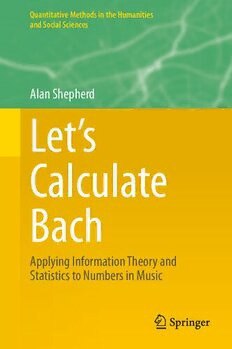Table Of ContentQuantitative Methods in the Humanities
and Social Sciences
Alan Shepherd
Let’s
Calculate
Bach
Applying Information Theory and
Statistics to Numbers in Music
Quantitative Methods in the Humanities
and Social Sciences
SeriesEditors
ThomasDeFanti,UniversityofCaliforniaSanDiego,LaJolla,CA,USA
AnthonyGrafton,PrincetonUniversity,Princeton,NJ,USA
ThomasE.Levy,UniversityofCaliforniaSanDiego,LaJolla,CA,USA
LevManovich,TheGraduateCenter,CUNY,NewYork,NY,USA
AlynRockwood,KAUST,Boulder,CO,USA
Moreinformationaboutthisseriesathttp://www.springer.com/series/11748
Alan Shepherd
Let’s Calculate Bach
Applying Information Theory and Statistics to
Numbers in Music
AlanShepherd
Dierdorf,Germany
ISSN2199-0956 ISSN2199-0964 (electronic)
QuantitativeMethodsintheHumanitiesandSocialSciences
ISBN978-3-030-63768-2 ISBN978-3-030-63769-9 (eBook)
https://doi.org/10.1007/978-3-030-63769-9
MathematicsSubjectClassification:94A15,62P99,65C05
©SpringerNatureSwitzerlandAG2021
Thisworkissubjecttocopyright.AllrightsarereservedbythePublisher,whetherthewholeorpartof
thematerialisconcerned,specificallytherightsoftranslation,reprinting,reuseofillustrations,recitation,
broadcasting,reproductiononmicrofilmsorinanyotherphysicalway,andtransmissionorinformation
storageandretrieval,electronicadaptation,computersoftware,orbysimilarordissimilarmethodology
nowknownorhereafterdeveloped.
Theuseofgeneraldescriptivenames,registerednames,trademarks,servicemarks,etc.inthispublication
doesnotimply,evenintheabsenceofaspecificstatement,thatsuchnamesareexemptfromtherelevant
protectivelawsandregulationsandthereforefreeforgeneraluse.
Thepublisher,theauthorsandtheeditorsaresafetoassumethattheadviceandinformationinthisbook
arebelievedtobetrueandaccurateatthedateofpublication.Neitherthepublishernortheauthorsor
theeditorsgiveawarranty,expressedorimplied,withrespecttothematerialcontainedhereinorforany
errorsoromissionsthatmayhavebeenmade.Thepublisherremainsneutralwithregardtojurisdictional
claimsinpublishedmapsandinstitutionalaffiliations.
ThisSpringerimprintispublishedbytheregisteredcompanySpringerNatureSwitzerlandAG
Theregisteredcompanyaddressis:Gewerbestrasse11,6330Cham,Switzerland
Illustration:©bytheauthor.
InGermanthenoteB iscalledBandBiscalledH,hencethenameBACHgivesthemelodyshown.
Thenotevaluesinquarternotesare2,1,3,8whichisBACHinthenumberalphabetwithA=1,
B=2,etc.
Calculemus.
Lasstunsrechnen.
Letuscalculate.
GottfriedWilhelmLeibniz(1646–1716)
Foreword
There is always one statement in a book that the author regrets almost as soon as
it is published. In my case, it appears on page 140 of Bach’s Numbers and reads:
“Theprobabilityofsixtermsbetween272and524fallingrandomlyintoaperfect
double2:1proportionisminimal.Bachmusthaveplannedit”.Combiningcompo-
sitionalintentionwithprobability,itwasaprovocativeinvitationtostatisticians.My
regretwasshort-lived,though,asitquicklyledtoafruitfulcollaborationwithAlan
Shepherdandtothisbook.
In October 2016, I received a short email from Alan inquiring about the 2017
BachNetworkDialogueMeeting,whichincludedthepassingcomment:“Iamvery
interestedinyourresearchonBach’snumbersandhaveyourtwobooks.Imayeven
beabletocontributesomethoughts”.AsBach’sNumbers:CompositionalProportion
andSignificancehadonlyjustbeenpublished,Irealisedthismustbeaseriousreader.
Twomonthslater,Alansentanabstractofthetopichewashopingtopresentatthe
DialogueMeeting:“Thispaperappliessomemathematicsandinformationtheoryto
mapoutthepossibilitiesofencodinginformationinmusicalscoresandputsthisin
perspectivewithsomecommonbiasesandfallaciestowhichmosthumansareprone
whenevaluatingprobabilitiessuchashowlikelyorimprobableanobservationis”.
WesetupaFaceTimecall.
Overtheyears,myresearchintothenumericalaspectsofBach’scompositional
processhashadamixedreception,withequalmeasuresofoutrightdismissal,enthusi-
asticacceptanceandlukewarmscepticism.Criticalscepticismwasmydefaultsetting
asamusicalanalyst.Myaimwastodiscoverwhatevidence,ifany,therewasbehind
thepopularcrazeofinterpretingnumbersinthestructuresofBach’sscores.Todo
thissystematically,IneededtoknowwhichnumbermethodsBachcouldhaveknown
andwhichcouldhavebeenappliedtomusicalcomposition.Myresearchturnedup
theoriginsofnumberalphabets,whichBachwouldhaveknown,andanexplanation
of how and when the fashion for gematria became associated with Bach’s music
(Tatlow 1991). Next I had toestablish aclear analytical method that would, as far
aspossible,uncoverevidenceofBach’sworkingmethod.Ratherthanusingestab-
lishedanalyticalmethods,IchosetousetoolsandconceptsthatBachhimselfwould
recognise,astheypromisedtotakemeclosertoBach’sthoughtprocesses.Iscoured
treatisesthatheownedorcouldhavereadforevidenceofhowhemighthaveordered
ix
x Foreword
hiscompositionsnumerically,ifatall.Iusedpencil,paperandsimplearithmeticasI
lookedatthestructuresofhisscores,intheirearly,revisedandfinalforms.Thistook
methroughanexplorationofwhetherornothecouldhaveusedthegoldensection
ortheFibonacciseries(Tatlow2006),tothediscoveryin2004ofwhatseemedtobe
anextraordinaryone-offuseoftheproportions1:2inseverallayerswithintheSix
SolosforViolin(BWV1001–1006).LatercametheunforgettablemomentwhenI
realised that it was only in the final revisions that the bar totals were whole round
numbersdividedbyclearlarge-scalelayersofproportion.Untilthatpoint,Ihadstood
safely on the side of the sceptics, but when I tentatively presented the first results
in December 2006 a colleague challenged me to cross the line. The first iteration
of the theory of proportional parallelism was published soon after (Tatlow 2007).
Like it or not, I found myself presenting new evidence to suggest that Bach had
deliberatelyusednumberstocreateproportionalorderinhiscompositions.Tatlow
(2007)heldmetoatheorywithathree-parttestthatIcontinuedtorefineasIcrit-
icised,wroteandrewrotewhatwouldbecomeBach’sNumbers(Tatlow2015).As
part of the test, I asked a colleague in 2010 to run a statistical exploration of my
results for the Six Solos for Violin to see the probability that these patterns were
intentionalonBach’spart.Heconcludedthatthe“nullhypothesis”gavenoreason
tobelieve thatmyhypothesis wastrue.Thisrancounter toagutinstinctbasedon
bothmygrowingunderstandingofhowBach’scontemporariesthoughtaboutmusic
andthenumerousexamplesinBach’smusicwithlayersoflarge-scaledoubleand
sometimestriple1:2or1:1proportion.Wasthenegativeresultbecausemycolleague
hadnotfactoredinsufficientdata?Wasitthatstatisticaltechniqueswereunsuitable
forhistoricalstudies?WhenAlanandIhadourfirstconversation6yearslaterthese
considerationswereuppermostinmymind.
InBach’sNumbers,Iwantedtopresenttheevidencetransparentlysothatscholars
from all disciplines, with negative or positive expectations, could read and weigh
up the evidence, test the theory for themselves, accept what rang true and reject
andreplacewhatdidnot.InPartI—Foundations—Ipresentthestrandsofhistorical
evidenceoncompositionalprocess,paralleltechniquesandbeliefsaboutproportions.
InPartII—Demonstrations—Igiveevidenceofthecompositionalhistorywithtables
of the final totals and their layers of 1:1 and 1:2 proportions for each of Bach’s
publishedworks.Sometablesaremoreconvincingthanothers,andIlikesomeof
themmorethanothers.Itseemedafairerandmorehonesttestofthetheorytoinclude
thedemonstrationsthatIfoundlessconvincing.Itisclearfromthevarietyofresults
that Bach had principles of ordering, but that there was no rigid code to which he
adhered.
I discovered that Bach’s works were layered with numerous proportioned units
nesting within each other, which I called parallel proportions. Combined with the
historicalevidence,itwastheingenuityoftheselayersthatpersuadedmetheyhad
been planned. A single 1:1 or 1:2 proportion formed by the number of bars, the
numberofmovementsorworksorbytheirsymmetricalarrangementcouldeasilybe
coincidental.Adouble1:1or1:2proportion,formedbythenumberofbars,andthe
number of movements or works, and their symmetrical arrangement seemed more
intentional,particularlywhensubdividedintoafurther1:1or1:2proportion,andeven
Foreword xi
moresowhenthesamethreeelementscombinedtoformatriple1:1or1:2proportion.
Thecaseforintentionalitybecameevenstrongerwhentheseproportionswerefurther
combinedwithdoubleortriple1:1or1:2proportionsatdifferentstructurallevels,
especiallywhenthesetwowereoftenlayeredwithtwoormorelayersofdoubleor
triple1:1or1:2proportion.
In the structure of Bach’s Six Solos for Violin, for example, the largest-scale
double 1:1 proportion is between the 6 Solos:6 Sonatas each with 2400:2400 bars
(Tatlow2015,133–158).Thenextlarge-scaledouble2:1proportioniswithintheSix
Solos,where4:2Solosareproportionedas1600:800bars.Thisisparalleltoanother
large-scaledouble2:1proportionwithintheSixViolinSonatas,with4:2Sonatasin
1600:800bars.
Atasmallerscale,single1:1and1:2proportionsarefoundinthefourmovements
oftheGminorSonata(BWV1001),with136:136barsand136:272bars(including
repeats).Thisisparalleltoyetanothersmaller-scalesingle2:1proportioninthefour
movementsoftheBminorPartita(BWV1002),both272:136barsand544:272bars
withrepeats.Astheproportionsareformedwithunitsof136bars,thereareseveral
additionallayersofproportionbetweentheGminorSonataandtheBminorPartita.
These results were supported by evidence of compositional adjustments that
Bach made as the work evolved. Combined with the many good theological and
aestheticreasonsthatBachandhiscontemporarieshadforcreatingperfectlyexecuted
symmetry,1:1and1:2proportions,itfeltacceptableinthisinstancetoclaiminten-
tionality. In 2016, Alan Shepherd set out with an open mind to test my hypoth-
esis,initiallydevelopingtheProportionalParallelExplorerprogramtofindsimple
proportionsandovertimerefiningittoisolatesimultaneouslayeringofproportions
withsymmetricallayouts.Ofinteresttousbothweretoseehowfarstatisticaland
computer-basedmethodscouldshedlightonwhetherBachintendedtheresultsIhad
discovered,whetheritwas“analyticalcoincidenceorBach’sdesign”,asIaskedin
2007(Tatlow2007).
It is fairly alarming to have one’s work scrutinised in minute detail. It is also a
great honour. When Alan Shepherd and I first spoke in 2016, we had no idea of
whatwouldresult.Forme,ithasmeantgainingacolleagueandfriend,buryingany
regretsaboutthatsentence(see10.4)andrealisinganewthatgoodold-fashionedgut
instinct still has a place in scholarship. I am grateful to Alan for his patience and
humility,anddelightedthatwiththisbookhehassucceededinpushingtheboundaries
of musicological methods, to narrow the gap at the intersection of compositional
intentionalityandnumericalconstruction.
Danderyd,Sweden RuthTatlow
July2020

